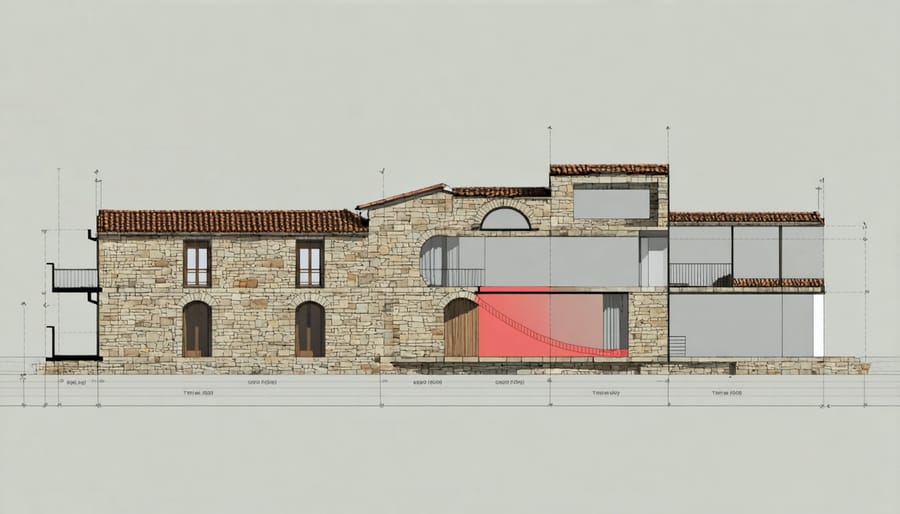From ancient monuments to modern architectural masterpieces, the journey of natural stone stands as testament to humanity’s enduring relationship with Earth’s most resilient building material. For millennia, natural stone has shaped our civilizations, offering unmatched durability, timeless beauty, and sustainable benefits that modern alternatives struggle to replicate.
Beyond its striking aesthetic appeal, natural stone delivers remarkable practical advantages. Its thermal mass properties naturally regulate indoor temperatures, reducing energy costs while creating comfortable living spaces. Each piece tells a unique geological story through distinct patterns, colors, and textures – characteristics that artificial materials simply cannot duplicate. Moreover, stone’s longevity and minimal maintenance requirements make it an environmentally conscious choice, often outlasting buildings themselves while requiring few chemical cleaners or treatments.
As we embrace sustainable architecture and design, natural stone’s inherent eco-friendly properties position it at the forefront of green building practices. Its extraction requires minimal processing, produces zero volatile organic compounds (VOCs), and creates materials that can be fully recycled or repurposed, embodying true environmental stewardship in construction and design.
Ancient Civilizations and Natural Stone
Monuments That Stood the Test of Time
Throughout history, natural stone has proven its extraordinary durability through countless architectural marvels that continue to inspire awe today. From the enduring Egyptian monuments like the Great Pyramids of Giza to the magnificent Roman Colosseum, these structures stand as testament to stone’s unmatched longevity.
The Parthenon in Athens, constructed from Pentelic marble in the 5th century BCE, continues to dominate the city’s skyline after 2,500 years. Similarly, the intricate carved temples of Petra, Jordan, hewn directly from rose-colored sandstone cliffs, have withstood centuries of desert winds and weather while maintaining their stunning detail.
More recent examples include the granite facades of many 19th-century banks and government buildings that remain virtually unchanged after more than 150 years of urban exposure. The Washington Monument, built from marble and granite, has maintained its structural integrity and pristine appearance since its completion in 1884.
These monuments demonstrate natural stone’s remarkable resistance to weathering, structural stability, and minimal maintenance requirements. While modern building materials may offer temporary cost advantages, stone’s proven track record of millennia-long performance makes it an unmatched choice for projects intended to leave a lasting legacy.

Cultural and Religious Significance
Throughout human history, natural stone has held profound cultural and spiritual significance across civilizations. From ancient sacred stone traditions to modern architectural marvels, stone continues to symbolize permanence, strength, and connection to the earth.
In ancient Egypt, granite and limestone were considered materials of the gods, used extensively in pyramids and temples to bridge the mortal and divine realms. Similarly, Greek and Roman cultures valued marble not just for its beauty, but as a symbol of power and enlightenment, incorporating it into their most important religious structures.
Native American cultures have long regarded certain stones as sacred objects, using them in healing ceremonies and spiritual practices. Many indigenous peoples worldwide continue to maintain deep spiritual connections with specific stone formations and quarries that have been sacred to their ancestors for generations.
In Asian cultures, particularly in Chinese and Japanese traditions, stones play vital roles in religious architecture and garden design, representing mountains and islands in miniature landscapes that encourage meditation and spiritual reflection.
Today, these cultural associations continue to influence modern design choices, with many architects and designers incorporating natural stone elements to create spaces that feel both grounded and transcendent. The enduring spiritual significance of stone speaks to its unique ability to connect us with our cultural heritage while creating meaningful spaces for future generations.
Natural Stone’s Historical Benefits
Durability and Longevity
The enduring legacy of natural stone as a building material is perhaps best exemplified by the magnificent structures that have withstood the test of time. The Great Pyramids of Giza, constructed over 4,500 years ago from limestone blocks, continue to stand as a testament to stone’s remarkable durability. Similarly, the Roman Colosseum, built in 80 AD using travertine stone, remains an architectural marvel despite centuries of exposure to the elements and seismic activity.
Modern testing has revealed that many natural stones can maintain their structural integrity for centuries, with granite showing exceptional resistance to weathering and compression strengths exceeding 200 MPa. This innate strength translates to practical benefits in contemporary applications, where stone installations often outlast the buildings they occupy.
Natural stone’s longevity extends beyond mere structural resilience. Unlike manufactured materials that may fade or deteriorate, stone’s appearance often improves with age, developing a distinctive patina that adds character and value. The marble floors of Italy’s Florence Cathedral, installed in the 14th century, still maintain their beauty and functionality despite millions of visitors walking across them annually.
Maintenance requirements for natural stone are surprisingly minimal when compared to other building materials. While initial installation costs may be higher, the extended lifespan and reduced replacement needs often result in lower long-term ownership costs. This durability factor is particularly evident in extreme environments, where stone surfaces continue to perform admirably in both freezing temperatures and intense heat, requiring only basic cleaning and occasional sealing to maintain their appearance and functionality.
Natural Temperature Regulation
Natural stone has served as a remarkable temperature regulator throughout human history, playing a vital role in traditional architecture across diverse climates. This inherent ability to moderate indoor temperatures stems from stone’s high thermal mass, which allows it to absorb, store, and gradually release heat throughout the day.
In warm climates, stone walls and floors absorb excess heat during the day, keeping interior spaces cooler. As temperatures drop at night, this stored heat is slowly released, creating a natural warming effect. This passive cooling and heating cycle has been particularly effective in desert regions, where dramatic temperature fluctuations between day and night require robust temperature management.
Ancient civilizations understood this principle well, incorporating thick stone walls in their structures to maintain comfortable living conditions. The Romans, for instance, utilized this property in their villas and public buildings, while Middle Eastern architecture featured stone construction to combat extreme desert temperatures.
Today, this natural temperature regulation continues to benefit modern buildings, reducing dependency on artificial heating and cooling systems. Studies show that buildings constructed with natural stone can experience up to 30% reduction in energy costs compared to conventional materials. This thermal efficiency is particularly valuable in sustainable architecture, where reducing energy consumption is a primary goal.
The effectiveness of stone’s temperature regulation varies by type and thickness. Dense stones like granite and limestone typically offer superior thermal mass properties, while proper wall thickness ensures optimal heat storage and distribution. This natural climate control capability makes stone an environmentally conscious choice for contemporary construction, combining traditional wisdom with modern sustainability needs.

Modern Benefits of Historical Stone Applications
Sustainable Building Practices
The enduring wisdom of ancient stone building techniques continues to influence modern sustainable architecture in remarkable ways. Our ancestors understood what contemporary research confirms: natural stone is one of the most environmentally responsible building materials available.
Traditional stone construction methods emphasized longevity and minimal environmental impact. These principles align perfectly with today’s sustainable building goals. Stone requires minimal processing compared to manufactured materials, resulting in a significantly lower carbon footprint. Its natural thermal mass properties help regulate indoor temperatures, reducing energy consumption for heating and cooling by up to 30% in properly designed buildings.
Modern sustainable stone practices build upon these historical foundations while incorporating new technologies. Today’s precision cutting techniques minimize waste, while improved transportation methods reduce the environmental impact of stone delivery. The material’s durability means it rarely needs replacement, and when a stone building is eventually deconstructed, the material can be readily repurposed or recycled.
Local sourcing, a cornerstone of traditional stone construction, remains vital in sustainable building. Using regional stone reduces transportation emissions while supporting local economies. This practice also ensures buildings harmonize with their surroundings, creating structures that are both environmentally conscious and aesthetically appropriate.
Water conservation, another crucial aspect of sustainable building, benefits from stone’s natural properties. Traditional rainwater harvesting systems often incorporated stone elements, a practice now being revived in modern sustainable design. Stone’s impermeability and durability make it ideal for water management features, from permeable pavers to rainfall collection systems.

Architectural Heritage Preservation
Natural stone stands as a testament to human architectural achievement, playing a crucial role in preserving our cultural heritage across millennia. From the ancient pyramids of Egypt to the grand cathedrals of Europe, stone structures have demonstrated remarkable longevity and historical significance that few other building materials can match.
The durability of natural stone has enabled these structures to withstand centuries of weathering, wars, and environmental challenges. This inherent strength makes it an ideal material for restoration projects, allowing conservators to maintain historical accuracy while ensuring structural integrity. When properly maintained, stone buildings can last for hundreds, even thousands of years, requiring minimal intervention compared to structures built with modern materials.
Stone’s ability to age gracefully adds to its historical value. The natural patina that develops over time tells the story of a building’s journey through history, creating an authentic character that cannot be replicated with artificial materials. This aesthetic evolution contributes to the cultural significance of historical structures while maintaining their structural stability.
Moreover, using natural stone in restoration projects helps preserve traditional craftsmanship and building techniques. Many historical preservation experts work to maintain these ancient methods, ensuring that future generations can continue to restore and maintain our architectural heritage using authentic materials and practices.
The thermal mass properties of stone have also contributed to the longevity of historical buildings, providing natural temperature regulation that has helped preserve interior spaces and their contents throughout centuries. This natural climate control system continues to benefit historical structures today, often proving more efficient than modern alternatives.
Contemporary Cultural Value
In today’s design landscape, natural stone continues to hold a prestigious position, bridging ancient building traditions with contemporary aesthetics. Modern architects and designers regularly incorporate stone elements to add authenticity, character, and timeless appeal to both residential and commercial spaces. The material’s inherent connection to nature resonates strongly with current sustainable design trends and the growing desire for biophilic elements in built environments.
Cultural appreciation for natural stone extends beyond its practical benefits. In an era of mass-produced materials, stone’s unique patterns and variations represent luxury, individuality, and craftsmanship. Each piece tells its own geological story, creating spaces that feel both grounded and sophisticated. This authenticity has particular appeal in our increasingly digital world, where tactile, natural materials provide a welcome counterpoint to synthetic surroundings.
The revival of traditional stonework techniques, combined with modern technology, has led to innovative applications that honor historical practices while meeting contemporary demands. From sleek marble kitchen islands to rustic limestone accent walls, stone installations serve as focal points that connect our modern spaces to centuries of architectural heritage.
Moreover, natural stone’s cultural value is enhanced by its sustainability credentials, aligning with growing environmental consciousness. Its durability and minimal processing requirements make it an attractive choice for those seeking eco-friendly building materials that don’t compromise on aesthetic appeal.
Throughout human history, natural stone has proven itself as more than just a building material – it stands as a testament to human ingenuity, artistic expression, and sustainable design. From the ancient pyramids of Egypt to modern sustainable architecture, stone continues to captivate and serve humanity with its unique combination of beauty, durability, and versatility.
The enduring benefits of natural stone remain as relevant today as they were thousands of years ago. Its exceptional longevity, minimal maintenance requirements, and inherent sustainability make it an environmentally responsible choice for modern construction. The material’s natural thermal properties contribute to energy efficiency, while its resistance to weather, fire, and wear ensures lasting value for generations.
Beyond its practical advantages, natural stone carries profound cultural significance. It connects us to our architectural heritage, tells stories of geological processes spanning millions of years, and grounds our built environment in authenticity. Each piece of stone brings unique patterns, textures, and colors that cannot be replicated by artificial materials, creating spaces with distinctive character and timeless appeal.
As we continue to seek sustainable, beautiful, and lasting solutions for our built environment, natural stone stands out as a material that bridges our past, present, and future. Its proven track record of performance, combined with its aesthetic versatility and environmental benefits, ensures its place as a premier building material for centuries to come.










